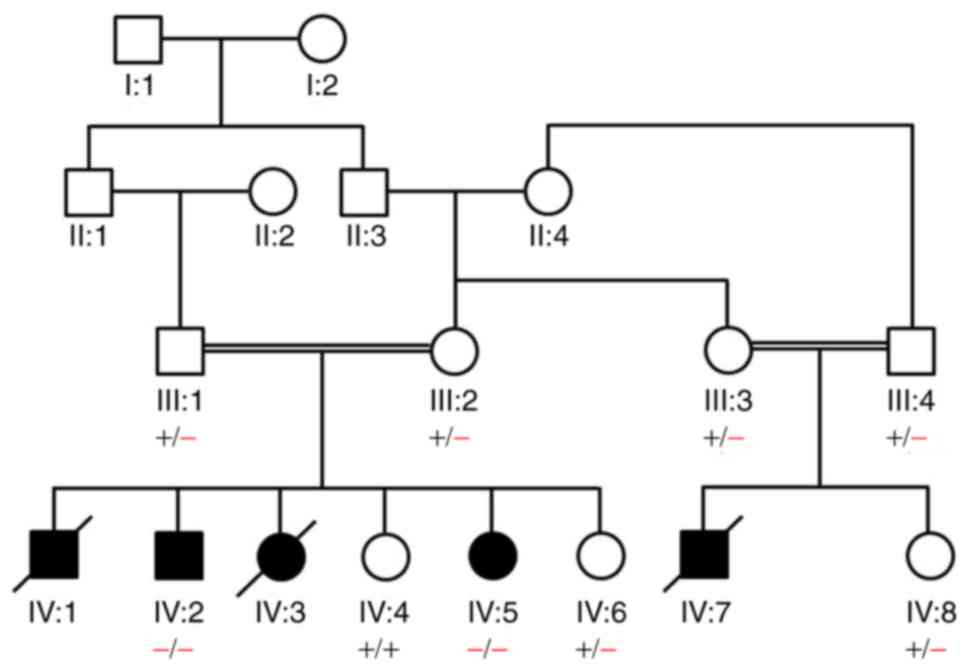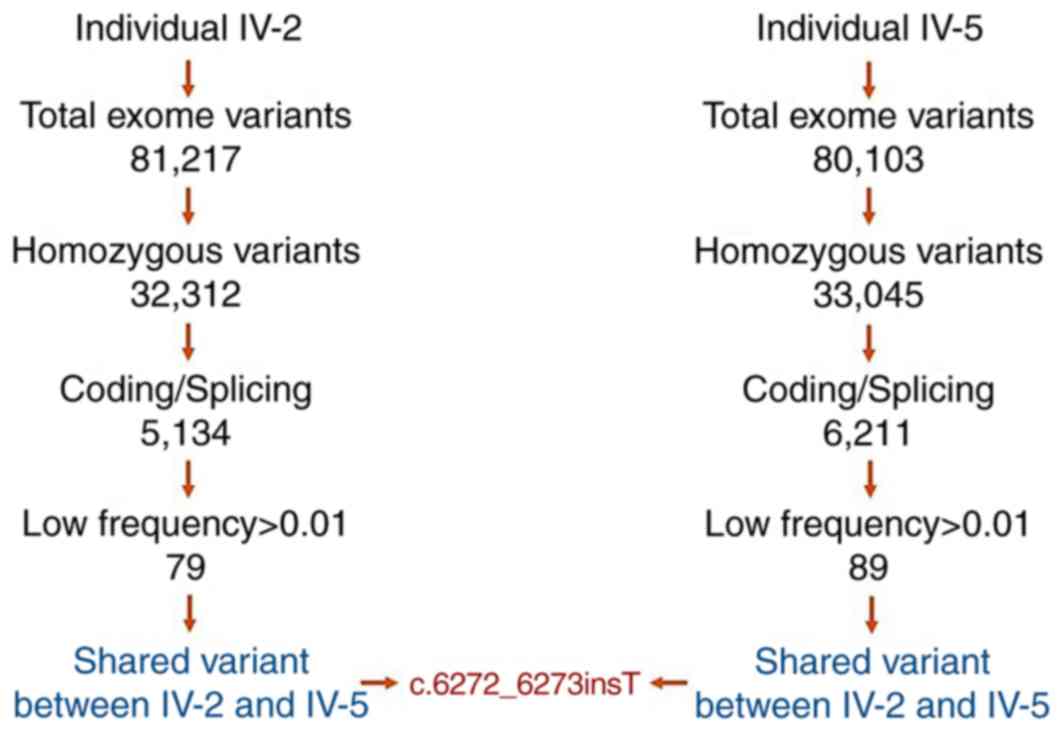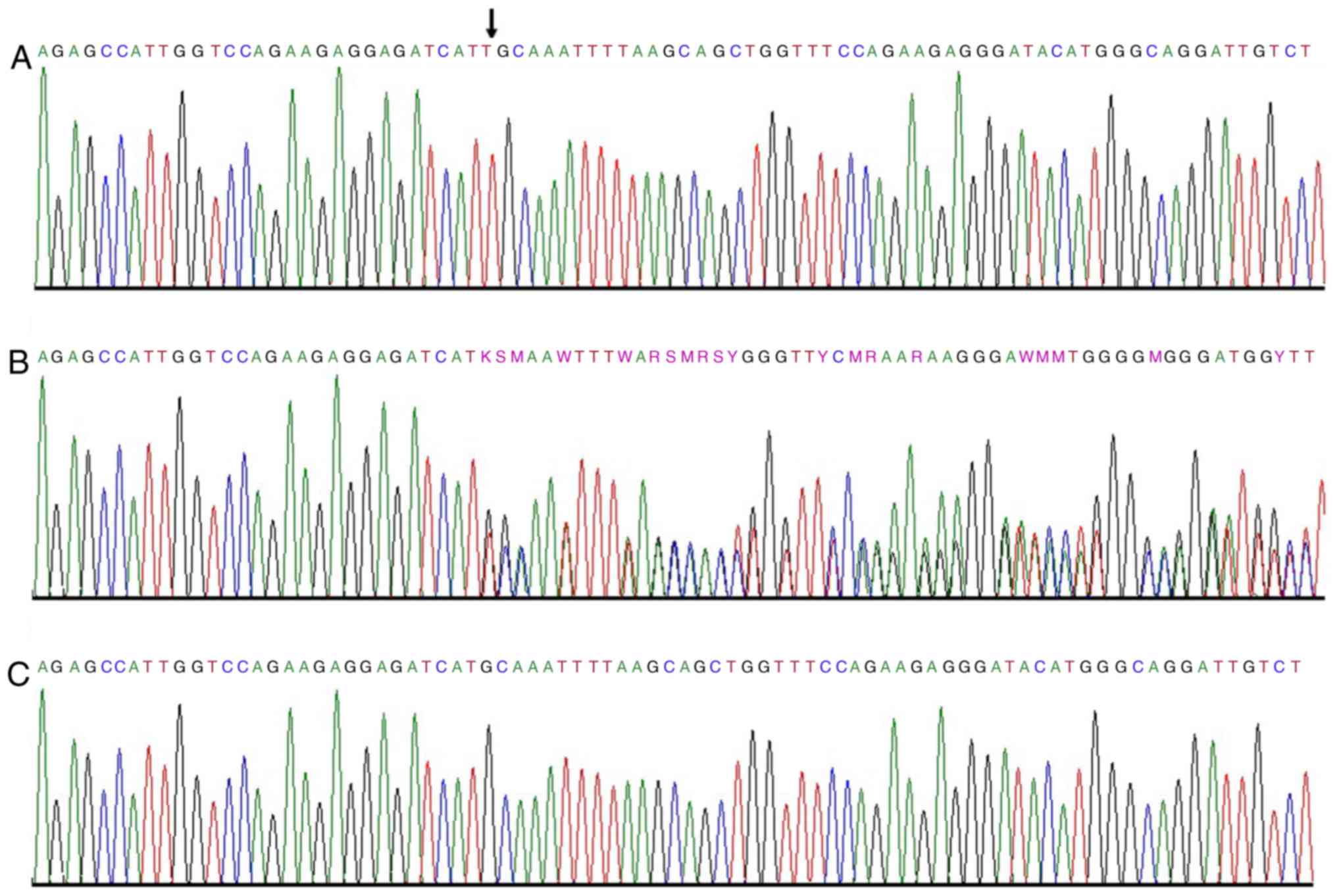|
1
|
Franceschini N, North KE, Kopp JB,
McKenzie L and Winkler C: NPHS2 gene, nephrotic syndrome and focal
segmental glomerulosclerosis: A HuGE review. Genet Med. 8:63–75.
2006. View Article : Google Scholar : PubMed/NCBI
|
|
2
|
Wong W: Idiopathic nephrotic syndrome in
New Zealand children, demographic, clinical features, initial
management and outcome after twelve-month follow-up: Results of a
three-year national surveillance study. J Paediatr Child Health.
43:337–341. 2007. View Article : Google Scholar : PubMed/NCBI
|
|
3
|
Schlesinger ER, Sultz HA, Mosher WE and
Feldman JG: The nephrotic syndrome. Its incidence and implications
for the community. Am J Dis Child. 116:623–632. 1968. View Article : Google Scholar : PubMed/NCBI
|
|
4
|
Cil O, Besbas N, Duzova A, Topaloglu R,
Peco-Antić A, Korkmaz E and Ozaltin F: Genetic abnormalities and
prognosis in patients with congenital and infantile nephrotic
syndrome. Pediatr Nephrol. 30:1279–1287. 2015. View Article : Google Scholar : PubMed/NCBI
|
|
5
|
Niaudet P and Boyer O: Pediatric
Nephrology. 6th. Avner E..Harmon W..Niaudet P..Yoshikawa N.:
Springer; New York, NY, USA: pp. 667–702. 1968
|
|
6
|
The primary nephrotic syndrome in
children. Identification of patients with minimal change nephrotic
syndrome from initial response to prednisone. A report of the
International Study of Kidney Disease in Children. J Pediatr.
98:561–564. 1981. View Article : Google Scholar : PubMed/NCBI
|
|
7
|
Habib R, Lévy M and Gubler MC:
Clinicopathologic correlations in the nephrotic syndrome.
Paediatrician. 8:325–348. 1979.PubMed/NCBI
|
|
8
|
Rood IM, Deegens JK and Wetzels JF:
Genetic causes of focal segmental glomerulosclerosis: Implications
for clinical practice. Nephrol Dial Transplant. 27:882–890. 2012.
View Article : Google Scholar : PubMed/NCBI
|
|
9
|
Tarshish P, Tobin JN, Bernstein J and
Edelmann CM Jr: Prognostic significance of the early course of
minimal change nephrotic syndrome: Report of the International
Study of Kidney Disease in Children. J Am Soc Nephrol. 8:769–776.
1997.PubMed/NCBI
|
|
10
|
Kestilä M, Lenkkeri U, Männikkö M,
Lamerdin J, McCready P, Putaala H, Ruotsalainen V, Morita T,
Nissinen M, Herva R, et al: Positionally cloned gene for a novel
glomerular protein-nephrin-is mutated in congenital nephrotic
syndrome. Mol Cell. 1:575–582. 1998. View Article : Google Scholar : PubMed/NCBI
|
|
11
|
Lovric S, Ashraf S, Tan W and Hildebrandt
F: Genetic testing in steroid-resistant nephrotic syndrome: When
and how? Nephrol Dial Transplant. 31:1802–1813. 2016. View Article : Google Scholar : PubMed/NCBI
|
|
12
|
Gbadegesin R, Lavin P, Foreman J and Winn
M: Pathogenesis and therapy of focal segmental glomerulosclerosis:
An update. Pediatr Nephrol. 26:1001–1015. 2011. View Article : Google Scholar : PubMed/NCBI
|
|
13
|
Sadowski CE, Lovric S, Ashraf S, Pabst WL,
Gee HY, Kohl S, Engelmann S, Vega-Warner V, Fang H, Halbritter J,
et al: A single-gene cause in 29.5% of cases of steroid-resistant
nephrotic syndrome. J Am Soc Nephrol. 26:1279–1289. 2015.
View Article : Google Scholar : PubMed/NCBI
|
|
14
|
Saleem MA: New developments in
steroid-resistant nephrotic syndrome. Pediatr Nephrol. 28:699–709.
2013. View Article : Google Scholar : PubMed/NCBI
|
|
15
|
Dyment DA, Sawyer SL, Chardon JW and
Boycott KM: Recent advances in the genetic etiology of brain
malformations. Curr Neurol Neurosci Rep. 13:3642013. View Article : Google Scholar : PubMed/NCBI
|
|
16
|
Rabbani B, Mahdieh N, Hosomichi K, Nakaoka
H and Inoue I: Next-generation sequencing: Impact of exome
sequencing in characterizing Mendelian disorders. J Hum Genet.
57:621–632. 2012. View Article : Google Scholar : PubMed/NCBI
|
|
17
|
Dixon-Salazar TJ, Silhavy JL, Udpa N,
Schroth J, Bielas S, Schaffer AE, Olvera J, Bafna V, Zaki MS,
Abdel-Salam GH, et al: Exome sequencing can improve diagnosis and
alter patient management. Sci Transl Med. 4:138ra782012. View Article : Google Scholar : PubMed/NCBI
|
|
18
|
Basit S, Al-Harbi KM, Alhijji SA, Albalawi
AM, Alharby E, Eldardear A and Samman MI: CIT, a gene involved in
neurogenic cytokinesis, is mutated in human primary microcephaly.
Hum Genet. 135:1199–1207. 2016. View Article : Google Scholar : PubMed/NCBI
|
|
19
|
Alharby E, Albalawi AM, Nasir A, Alhijji
SA, Mahmood A, Ramzan K, Abdusamad F, Aljohani A, Abdelsalam O,
Eldardear A and Basit S: A homozygous potentially pathogenic
variant in the PAXBP1 gene in a large family with global
developmental delay and myopathic hypotonia. Clin Genet.
92:579–586. 2017. View Article : Google Scholar : PubMed/NCBI
|
|
20
|
Al-Hamed M, Sayer JA, Al-Hassoun I,
Aldahmesh MA and Meyer B: A novel mutation in NPHS2 causing
nephrotic syndrome in a Saudi Arabian family. NDT Plus. 3:545–548.
2010.PubMed/NCBI
|
|
21
|
Al-Hamed MH, Al-Sabban E, Al-Mojalli H,
Al-Harbi N, Faqeih E, Al Shaya H, Alhasan K, Al-Hissi S, Rajab M,
Edwards N, et al: A molecular genetic analysis of childhood
nephrotic syndrome in a cohort of Saudi Arabian families. J Hum
Genet. 58:480–489. 2013. View Article : Google Scholar : PubMed/NCBI
|
|
22
|
Hashmi JA, Al Harbi KM, Ramzan K, Albalwi
AM, Mehmood A, Samman MI and Basit S: A novel splice-site mutation
in the ASPM gene underlies autosomal recessive primary
microcephaly. Ann Saudi Med. 36:391–396. 2016. View Article : Google Scholar : PubMed/NCBI
|
|
23
|
Li H: Aligning sequence reads, clone
sequences and assembly contigs with BWA-MEM. arXiv.
1303:39972013.
|
|
24
|
Van der Auwera GA, Carneiro MO, Hartl C,
Poplin R, Del Angel G, Levy-Moonshine A, Jordan T, Shakir K, Roazen
D, Thibault J, et al: From FastQ data to high-confidence variant
calls: The genome analysis toolkit best practices pipeline. Curr
Protoc Bioinformatics. 11:11.10.1. 11.10.33. 2013. View Article : Google Scholar :
|
|
25
|
Basit S, Malibari O, Al Balwi AM,
Abdusamad F and Ismail Abu F: A founder splice site mutation
underlies glycogen storage disease type 3 in consanguineous Saudi
families. Ann Saudi Med. 34:390–395. 2014. View Article : Google Scholar : PubMed/NCBI
|
|
26
|
Letunic I, Doerks T and Bork P: SMART:
Recent updates, new developments and status in 2015. Nucleic Acids
Res. 43:(Database Issue). D257–D260. 2015. View Article : Google Scholar : PubMed/NCBI
|
|
27
|
Al-Hamed MH, Al-Sabban E, Al-Mojalli H,
Al-Harbi N, Faqeih E, Al Shaya H, Alhasan K, Al-Hissi S, Rajab M,
Edwards N, et al: A molecular genetic analysis of childhood
nephrotic syndrome in a cohort of Saudi Arabian families. J Hum
Genet. 58:480–489. 2013. View Article : Google Scholar : PubMed/NCBI
|
|
28
|
Tadano M, Edamatsu H, Minamisawa S,
Yokoyama U, Ishikawa Y, Suzuki N, Saito H, Wu D, Masago-Toda M,
Yamawaki-Kataoka Y, et al: Congenital semilunar valvulogenesis
defect in mice deficient in phospholipase C epsilon. Mol Cell Biol.
25:2191–2199. 2005. View Article : Google Scholar : PubMed/NCBI
|
|
29
|
Ogino D, Hashimoto T, Hattori M, Sugawara
N, Akioka Y, Tamiya G, Makino S, Toyota K, Mitsui T and Hayasaka K:
Analysis of the genes responsible for steroid-resistant nephrotic
syndrome and/or focal segmental glomerulosclerosis in Japanese
patients by whole-exome sequencing analysis. J Hum Genet.
61:137–141. 2016. View Article : Google Scholar : PubMed/NCBI
|
|
30
|
Bullich G, Trujillano D, Santín S,
Ossowski S, Mendizábal S, Fraga G, Madrid Á, Ariceta G, Ballarín J,
Torra R, et al: Targeted next-generation sequencing in
steroid-resistant nephrotic syndrome: Mutations in multiple
glomerular genes may influence disease severity. Eur J Hum Genet.
23:1192–1199. 2015. View Article : Google Scholar : PubMed/NCBI
|
|
31
|
Hinkes B, Wiggins RC, Gbadegesin R,
Vlangos CN, Seelow D, Nürnberg G, Garg P, Verma R, Chaib H, Hoskins
BE, et al: Positional cloning uncovers mutations in PLCE1
responsible for a nephrotic syndrome variant that may be
reversible. Nat Genet. 38:1397–1405. 2006. View Article : Google Scholar : PubMed/NCBI
|
|
32
|
Boyer O, Benoit G, Gribouval O, Nevo F,
Pawtowski A, Bilge I, Bircan Z, Deschênes G, Guay-Woodford LM, Hall
M, et al: Mutational analysis of the PLCE1 gene in steroid
resistant nephrotic syndrome. J Med Genet. 47:445–452. 2010.
View Article : Google Scholar : PubMed/NCBI
|


















